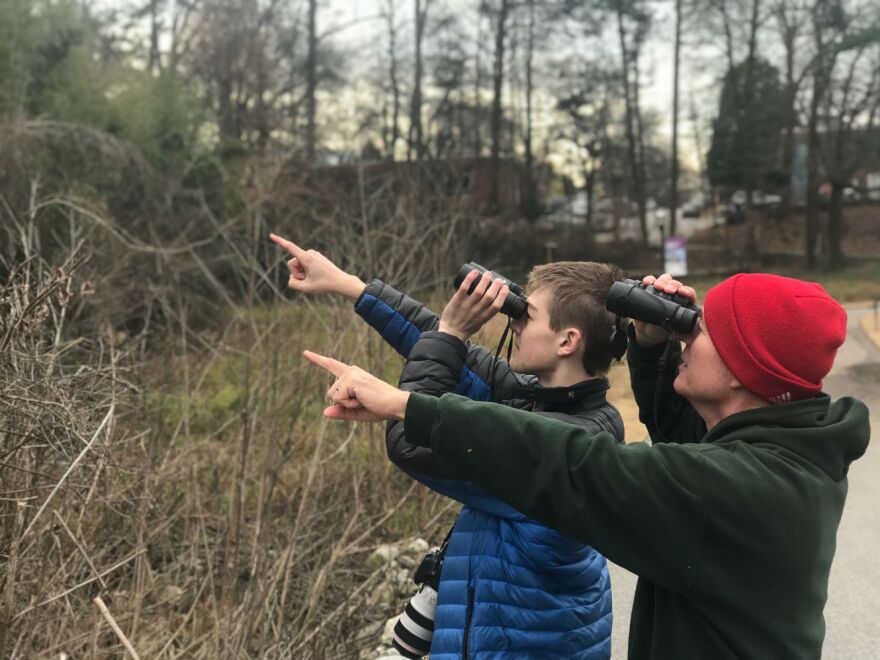From the killer bee-infested border region of southeast Arizona to the sultry islands of the Galapagos, Warblers & Woodpeckers recounts the quest of a father and his thirteen-year-old son to see as many birds as possible in a single year.
The following highlights are from a conversation with Sneed and Braden Collard about the book, "Warblers and Woodpeckers: A Father-Son Big Year of Birding." To hear the full conversation click the link above or subscribe to our podcast.
Sarah Aronson: In birdwatching terms, what is a nemesis bird?
Sneed Collard: Oh man, I think you should start with that, Braden.
Braden Collard: We have two examples of nemesis birds. Our main one, which most recently became not a nemesis bird anymore, is called a snow bunting. It’s a bird we’ve looked for maybe half a dozen or a dozen different times and just never found. We’ve been so unlucky; we’ve just never seen it before. A nemesis bird is a past a bird you’ve never seen before, it’s a bird you’ve looked for a lot but just never found it.
Is there a certain emotional quality attached to a nemesis bird?
SC: Yeah there is. And birds that didn’t use to be nemesis birds can become nemesis birds and it really starts pissing you off when you don’t see them.
BC: Snow buntings were really angering for us.
SC: Braden and I did a big weekend over Memorial Day and Braden and Nick Ramsey kept seeing dippers and I kept missing them. By the end of the week, I was really getting annoyed by that. They can really get under your skin.
Braden, what got you into birding in the first place?
BC: Watching the movie “The Big Year” got me into it. Since I’d been really young I’ve been into animals of all kinds, and I’ve also been into collecting things. When I saw the movie “The Big Year,” the idea of collecting birds for a year struck me. I decided I wanted to try that out, and we’ve just stuck with it ever since.
For those of us unfamiliar, can you give us a brief account of the rules of the American Birding Association for counting birds?
SC: It’s really on the honor system, the whole thing. You can either see a bird or you can identify it from its call. Now, especially during our Big Year, we knew very few bird calls, so we made ourselves see every bird. . . They trust you to evaluate your own abilities and to make the identification.
Now that doesn’t mean there isn’t some controversy. We’ve talked to some very prominent birders lately who have deep suspicions about other birders and whether they’re really seeing these birds that they’re putting on their list. But I would guess that 99.9% of the birders out there are very honorable people and the people trying to set records usually have photographic evidence.
Braden, one of the things that impressed me about your character in the book, which is that you held yourself to a very high standard about seeing the birds. . . what do you know about that part of you that really has this integrity?
BC: I just know that I’ve always had it and I definitely got it from my dad and mom. But also birding is based on the honor system and that’s partly because you can lie about it, but you’re not earning anything really. People might be like, “Oh, he saw that bird,” but if you know you didn’t see it, you didn’t really win anything by lying. I want to make sure I’ve seen or heard the bird and know how to identify it before I count it.

About the Book:
From the killer bee-infested border region of southeast Arizona to the sultry islands of the Galapagos, Warblers & Woodpeckers recounts the quest of a father and his thirteen-year-old son to see as many birds as possible in a single year. With a measured blend of humor, natural history, and adventure, this tale takes readers to great birding hotspots of America and beyond, both to experience their incredible avian wealth and to experience the focused, often eccentric, world of ornithological travel. Along the way, readers share the ups and downs of the relationship between a father and his teenage son.
Writer Sneed Collard and his son Braden set out to establish their own personal Big Year bird species count record. In Warblers & Wood peckers, Sneed shares the excitement, challenges, perils, and insights that come with crisscrossing the country in search of some of Earth’s most remarkable creatures. It’s a father-and-son tale, in which the adventure is in the journey and the surprising discoveries and encounters with our wondrous feathered friends. Sneed brings a fast-paced yet generous voice to the attempt, and readers of all stripes will appreciate the way backyard birders can create their own Big Year.
About the Author:

Sneed B. Collard IIIis the author of morethan seventy-five books, along with countless magazine articles for bothchildren and adults. He is the recipient of the Washington PostChildren’s Book Guild Nonfiction Award for his body of work, while one of his newesttitles for kids, Hopping Ahead of Climate Change: Snowshoe Hares, Science, and Survival, was a finalist for 2016’s AAAS/Subaru Science Books & Films Prize for Excellence in Science Books. The Collards live in Missoula, Montana, and you can learn more about Sneed at sneedbcollardiii.com and his father-son birding at FatherSonBirding.com


